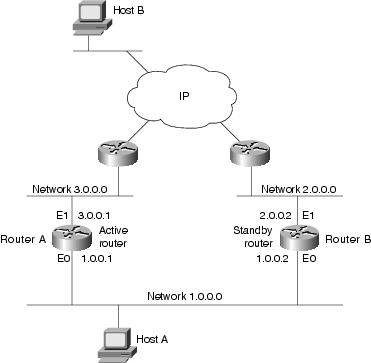HSRP uses a priority scheme to determine which HSRP-configured router is to be the default active router. To configure a router as the active router, you assign it a priority that is higher than the priority of all the other HSRP-configured routers. The default priority is 100, so if you configure just one router to have a higher priority, that router will be the default active router.

All hosts on the network are configured to use the IP address of the virtual router (in this case, 1.0.0.3) as the default gateway. The command for configuring the default gateway depends on the host's operating system, TCP/IP implementation, and configuration.
Note ![]() The configurations shown in this case study use the Enhanced IGRP routing protocol. HSRP can be used with any routing protocol supported by the Cisco IOS software. Some configurations that use HSRP still require a routing protocol to converge when a topology change occurs. The standby router becomes active, but connectivity does not occur until the protocol converges.
The configurations shown in this case study use the Enhanced IGRP routing protocol. HSRP can be used with any routing protocol supported by the Cisco IOS software. Some configurations that use HSRP still require a routing protocol to converge when a topology change occurs. The standby router becomes active, but connectivity does not occur until the protocol converges.
The following is the configuration for Router A:
hostname RouterA
!
interface ethernet 0
ip address 1.0.0.1 255.0.0.0
standby 1 ip 1.0.0.3
standby 1 preempt
standby 1 priority 110
standby 1 authentication denmark
standby 1 timers 5 15
!
interface ethernet 1
ip address 3.0.0.1 255.0.0.0
!
router eigrp 1
network 1.0.0.0
network 3.0.0.0
The following is the configuration for Router B:
hostname RouterB
!
interface ethernet 0
ip address 1.0.0.2 255.0.0.0
standby 1 ip 1.0.0.3
standby 1 preempt
standby 1 authentication denmark
standby 1 timers 5 15
!
interface ethernet 1
ip address 2.0.0.2 255.0.0.0
!
router eigrp 1
network 1.0.0.0
network 2.0.0.0
The standby ip interface configuration command enables HSRP and establishes 1.0.0.3 as the IP address of the virtual router. The configurations of both routers include this command so that both routers share the same virtual IP address. The 1 establishes Hot Standby group 1. (If you do not specify a group number, the default is group 0.) The configuration for at least one of the routers in the Hot Standby group must specify the IP address of the virtual router; specifying the IP address of the virtual router is optional for other routers in the same Hot Standby group.
The standby preempt interface configuration command allows the router to become the active router when its priority is higher than all other HSRP-configured routers in this Hot Standby group. The configurations of both routers include this command so that each router can be the standby router for the other router. The 1 indicates that this command applies to Hot Standby group 1. If you do not use the standby preempt command in the configuration for a router, that router cannot become the active router.
The standby priority interface configuration command sets the router's HSRP priority to 110, which is higher than the default priority of 100. Only the configuration of Router A includes this command, which makes Router A the default active router. The 1 indicates that this command applies to Hot Standby group 1.
The standby authentication interface configuration command establishes an authentication string whose value is an unencrypted eight-character string that is incorporated in each HSRP multicast message. This command is optional. If you choose to use it, each HSRP-configured router in the group should use the same string so that each router can authenticate the source of the HSRP messages that it receives. The "1" indicates that this command applies to Hot Standby group 1.
The standby timers interface configuration command sets the interval in seconds between hello messages (called the hello time) to five seconds and sets the duration in seconds that a router waits before it declares the active router to be down (called the hold time) to eight seconds. (The defaults are three and 10 seconds, respectively.) If you decide to modify the default values, you must configure each router to use the same hello time and hold time. The "1" indicates that this command applies to Hot Standby group 1.

No comments:
Post a Comment